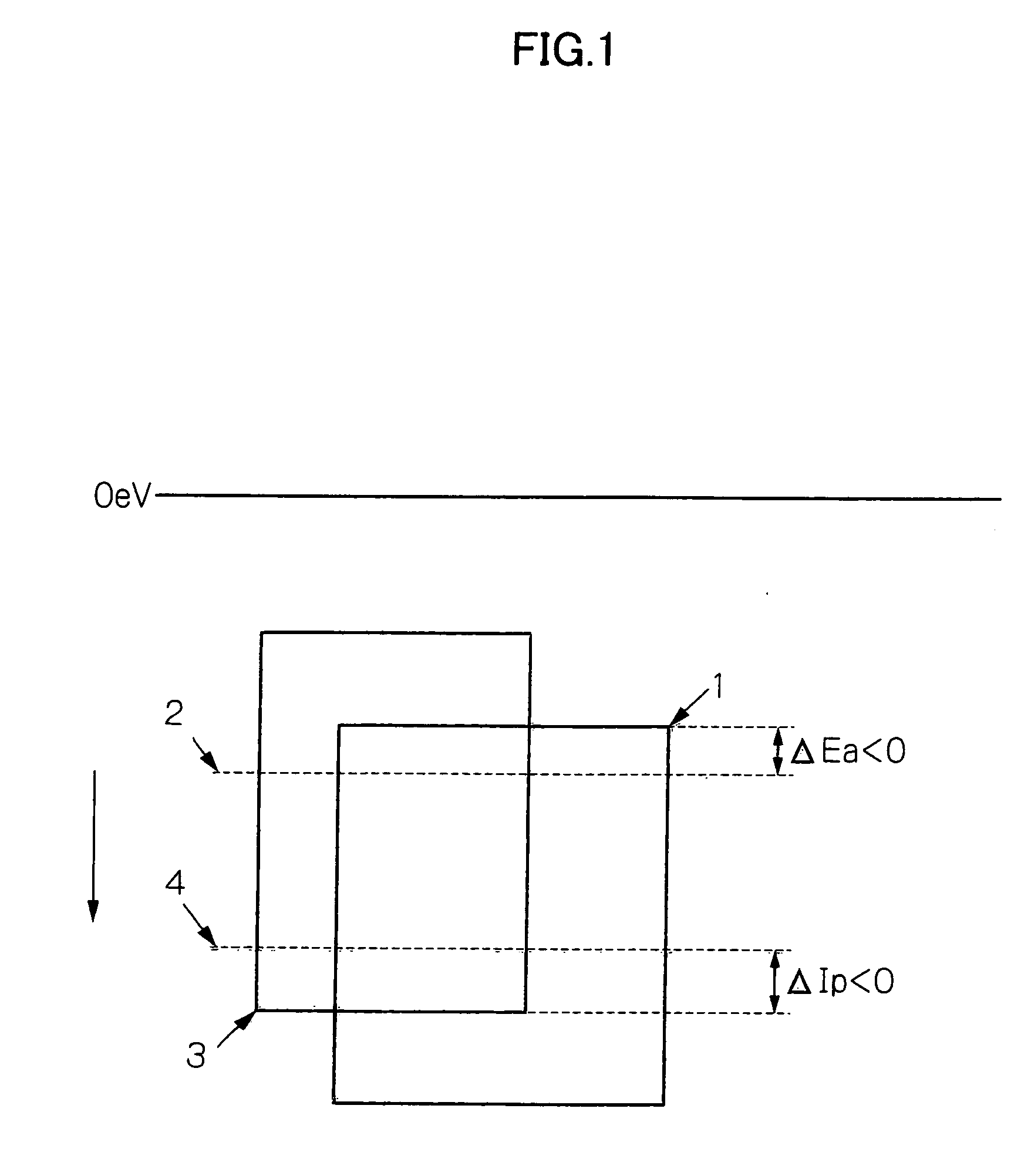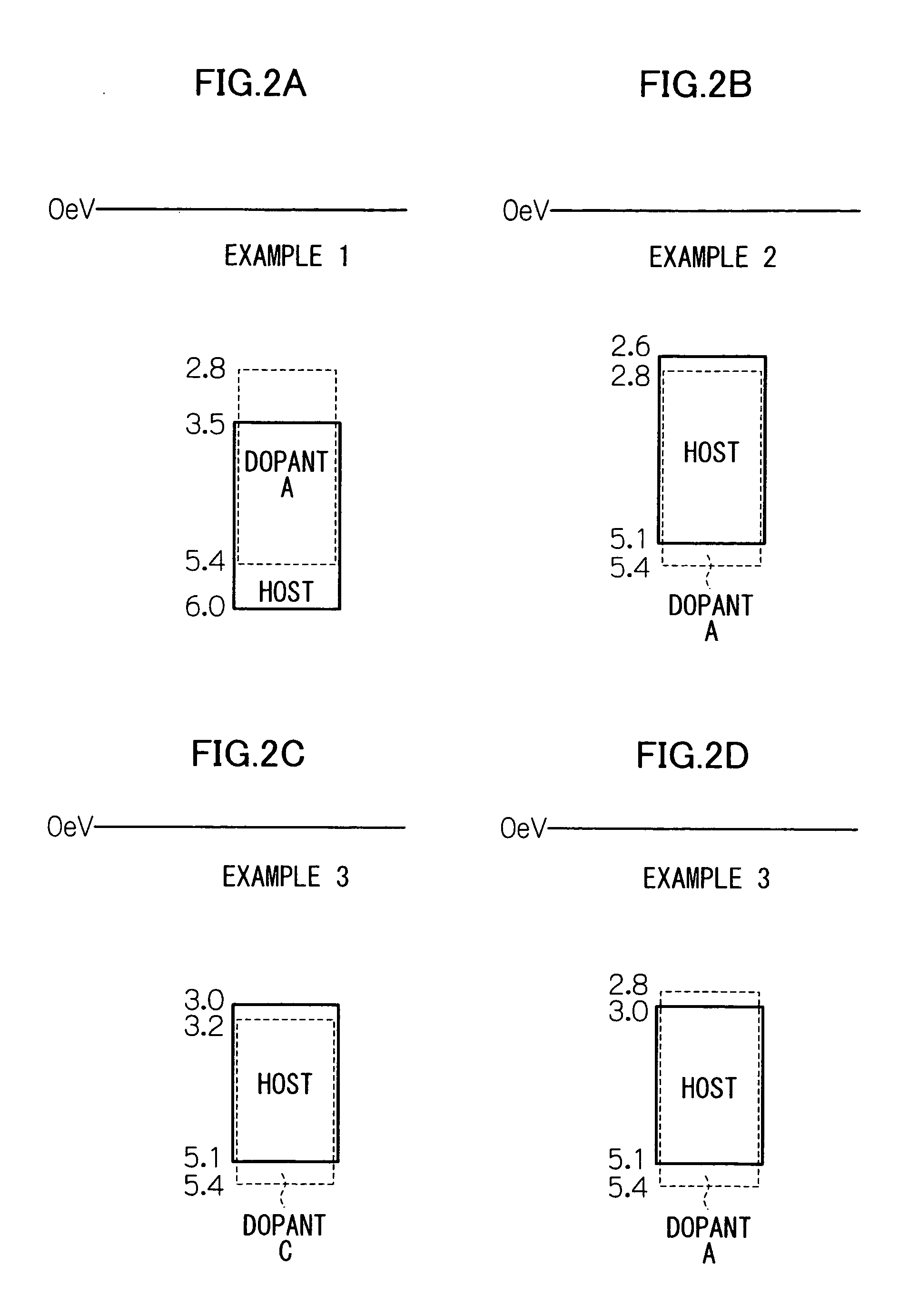Organic electroluminescent element
a technology of electroluminescent elements and organic materials, which is applied in the direction of discharge tubes/lamp details, luminescent screens of discharge tubes, natural mineral layered products, etc., can solve the problems of phosphorescent materials inevitably deteriorating, reducing driving durability and light emission efficiency, and achieve excellent driving durability , high luminescent efficiency, the effect of improving driving durability
- Summary
- Abstract
- Description
- Claims
- Application Information
AI Technical Summary
Benefits of technology
Problems solved by technology
Method used
Image
Examples
example 1
[0162] To one where on a glass substrate an indium / tin oxide (ITO) transparent conductive film was deposited by 150 nm (manufactured by Geomatic Co., Ltd.), by use of photolithography and hydrochloric acid etching, the patterning was applied and thereby a anode was formed. The patterned ITO substrate, after washing in an order of ultrasonic washing with acetone, water washing with pure water and ultrasonic washing with isopropyl alcohol, was dried under nitrogen blow, finally followed by UV ozone cleaning, and was disposed in a vacuum deposition unit. Thereafter, the vacuum deposition unit was evacuated to a degree of vacuum of 2.7×10−4 Pa or less.
[0163] Subsequently, in the deposition unit, copper phthalocyanine (CuPc) shown below was heated and deposited at a deposition speed of 0.1 nm / sec, and thereby a hole injecting layer having a film thickness of 10 nm was formed.
[0164] In the next place, on the hole injecting layer formed according to the above, 4,4′-bis[N-(1-naphtyl)-N-p...
example 2
[0177] An organic EL element was prepared and measured in the same manner as in example 1, except that a mixture (75:25 by weight ratio) of a hole transporting host 3 below and an electron transporting host 2 below was used as the host materials contained in a luminescent layer.
[0178] The maximum wavelength of a light emission spectrum of the element obtained according to example 2 was 584 nm and identified to be derived from the dopant B.
Electron Transporting Host 2
example 3
[0184] An organic electroluminescent element was prepared in the same manner as in example 1, except that, as the host materials contained in a luminescent layer, a mixture (75:25 by weight ratio) of a hole transporting host 3 and an electron transporting host 3 shown below, and as phosphorescent organic metal complexes as the dopant materials, the tris(2-phenylpyridine)iridium (dopant A) and an iridium complex (dopant C) below were heated, and a luminescent layer was formed by use of a ternary simultaneous vapor deposition method. Relationships between the ionization potentials and the electron affinities of the phosphorescent materials and the host materials are shown in Table 2. Furthermore, energy states of example 3 are shown in FIGS. 2C and 2D.
TABLE 2Phosphorescent materialCPhosphorescent materialAHost material (mixingHole transporting hostratio)3:Electron transporting host 3 (75:25)Ip(D1) (eV)5.4Ip(D2) (eV)5.4Ip(H)min (eV)5.1Ip(H)min (eV)5.1ΔIp1: Ip(D1) − Ip(H)min0.3ΔIp2: I...
PUM
| Property | Measurement | Unit |
|---|---|---|
| Energy | aaaaa | aaaaa |
| Energy | aaaaa | aaaaa |
| Energy | aaaaa | aaaaa |
Abstract
Description
Claims
Application Information
 Login to View More
Login to View More - R&D
- Intellectual Property
- Life Sciences
- Materials
- Tech Scout
- Unparalleled Data Quality
- Higher Quality Content
- 60% Fewer Hallucinations
Browse by: Latest US Patents, China's latest patents, Technical Efficacy Thesaurus, Application Domain, Technology Topic, Popular Technical Reports.
© 2025 PatSnap. All rights reserved.Legal|Privacy policy|Modern Slavery Act Transparency Statement|Sitemap|About US| Contact US: help@patsnap.com



